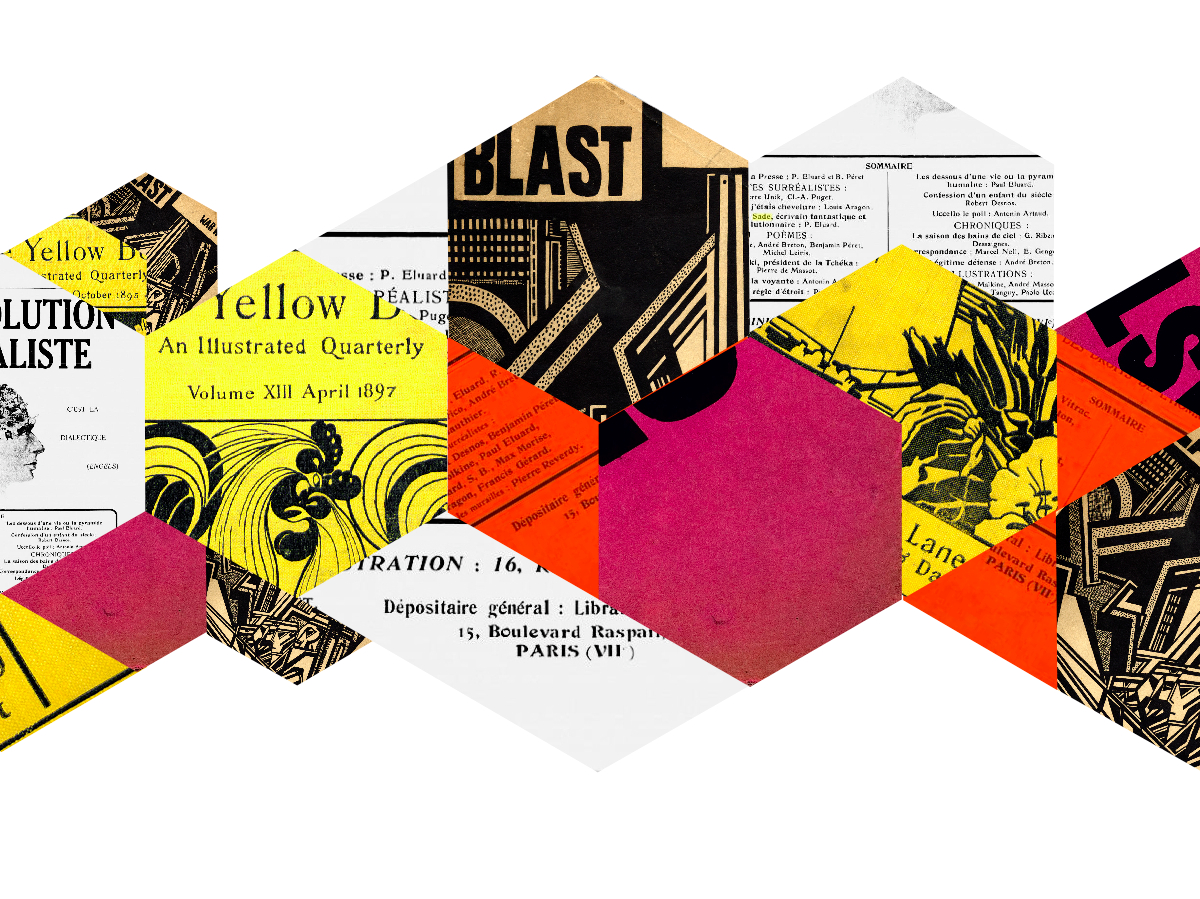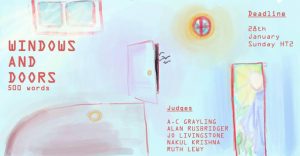
Little Magazines
by Molly Brown | February 11, 2014
Being a professional poet is no picnic. In order to be noticed, you must be read, and that’s where little magazines become important. Publishing poetry and short stories, alongside art, reviews, and comment pieces, little magazines have, since their inception, been both small enough to print the unknown work of emerging poets and influential enough to change the direction of literature. Arguably the earliest little magazine was Ralph Waldo Emerson’s The Dial (1840-44), and from there their influence can be traced from the infamous Yellow Book (1894-97), to the revolutionary modernist publications epitomised by BLAST – the magazine that launched Vorticism, the modernist movement influenced by cubism and futurism. Explicitly revolutionary publications have always run alongside mainstream magazines, but contemporary literary journals have nothing of the sway of their early twentieth century predecessors. Beyond well-established giants like The Poetry Review, such magazines are few and far between, creating an environment in which publication is a considerable feat.
In opposition to the current scarcity of little magazines, the first two decades of the twentieth century saw a boom in publication. In Paris between 1910 and 1914 there were between thirty and fifty little magazines circulating in the city simultaneously—indicative of a self-consciously avant-garde climate. Modernism was, to an extent, characterised by a succession of literary and artistic movements founded by circles of like-minded people. Little magazines became integral to such cultural groups, both by bringing contributors together, and in propagating and disseminating their ideas. From 1909, following Filippo Marinetti’s ‘Futurist Manifesto’, published first in La Gazzetta dell’Emilia, then reproduced in Le Figaro, it became common for new movements to declare themselves in printed manifestos. For example, in the March 1913 edition of Poetry, a Chicago-based little magazine that is still in publication, Ezra Pound printed A Few Don’ts by an Imagiste and an essay Imagisme, announcing the Imagist movement that had been emerging in Europe. Little magazines became the perfect organ for both the advertisement and the proliferation of such movements.
Moreover, the very littleness that defines the genre allowed these magazines to do that which a larger publication couldn’t – they were able to select internally consistent content from among their small circle of associates. This meant that, in many respects, little magazines were not only promotions for external literary or artistic movements, but encapsulated the movements themselves. Wyndham Lewis’ BLAST (1914-14), or André Breton’s La Révolution Surealiste (1924-29), are perhaps the most proclaimed examples. The first issue of BLAST contained two manifestos, along with lengthy lists of things to ‘blast’ and ‘bless’. Readers were called upon to ‘blast’, amongst other things, ‘France’, ‘sentimental hygienics’, ‘slippers’, ‘aperitifs’, ‘the specialist’, ‘the art-pimp’, ‘vegetable humanity’, ‘Edward Elgar’, and ‘fraternising with monkeys’. Most revealing, perhaps, is the blast of ‘the years 1837 to 1900’ indicating the reactionary aims of Vorticism. Lewis’ magazine was intentionally provocative and combative; not only does the content explain Vorticist ideals, typographical experimentation meant that the words themselves matched the aesthetic of the art. Little magazines like BLAST were, in a sense, more than just publications containing manifestos, they were manifestos themselves, not only declaring a change in direction of poetic and artistic style, but demonstrating and embodying it.
Little magazines were also important arenas for literary debate, allowing dialogue between movements. Within the interlinking social circles around publications, articles were discussed and responses were given in competing magazines. Reviews were refuted, theories disputed. The New Age was renowned for not only engaging actively in such debates, but for setting up debates between two of its own writers, or even publishing the arguments of one writer against herself, using two pseudonyms simultaneously. The genre was also influential in disseminating ideas about art and literature across continents. For example, Close Up (1927-33), an ‘international magazine devoted to film art’, was edited in Switzerland, printed in Dijon and England, and read in Berlin, Moscow, Paris, New York and London. On a smaller scale, Rhythm had regular reports on the cultural scene in Paris, and in August 1912 The Poetry Review published an overview by Flint describing various artistic movements in Europe. Little magazines were, indeed, one of the main ways in which foreign art reached Britain: Picasso was first printed in Britain in Rhythm magazine in the summer of 1911.
Dora Marsden’s The Freewoman (1911-2) and The New Freewoman (1913-14) were notoriously radical publications that argued that feminism meant more than just the right to vote. Articles freely discussed sexuality, encouraged women to remain unmarried, advocated free love, tolerated homosexuality, envisaged the domestic man, and idealised the New Woman. Modernist little magazines prided themselves on printing these forward-thinking opinions, and disseminating controversial material – James Joyce’s provocative A Portrait of the Artist as a Young Man was first published in The Egoist (1914-19), also edited by Marsden. The threat of censorship loomed over little magazines, and in 1921 the Ulysses obscenity trial forced The Little Review to discontinue their serialisation of the novel, and restrict the magazine’s content to less inflammatory material.
Little magazines prided themselves on being marginal publications and refused to be dictated by the demands of their readers. This gave them the independence of thought necessary to be innovative and daring, in a way that would be unsustainable for traditional publications. The inevitable consequence of this is that little magazines are infamously hard to keep afloat. The inclusion of advertisements as a means of generating income was often controversial – many publications choosing to dismiss them as a degradation of an artistic enterprise. This, combined with short print runs and small circulations, has always meant that they are rarely financially viable, some lasting for as few as two editions. In 1896 W H Smith withdrew The Savoy from its shelves, leading to its collapse, and in 1911, huge financial losses resulted in Katherine Mansfield sacrificing her entire year’s allowance to rescue Rhythm. But financial failure was often equated to literary success, a narrative that editors like Ford Maddox Ford of the economically tumultuous English Review were keen to encourage. Ezra Pound made it clear that ‘verse to be of any intellectual value, could not be selected merely on the basis of immediate earning capacity,’ believing that only in a reader’s discomfort could there be enlightenment. But discomforting reading does not sell, and the financial struggles of little magazines became a badge of honour. Editors liked to propagate the idea of little magazines struggling against the philistinism of the uncomprehending masses, and the evils of commercialisation.
As proven by Miller and Price’s extensive survey, British Poetry Magazines 1914-2000, little magazines outlived modernism and continue to be a major channel for the publication of new writing. Nonetheless, little magazines are rarer, and it is clear that they have lost their revolutionary zeal. Poetry enthusiasts might subscribe to American journals like The Kenyon Review, Poetry, and The Literary Review, or the British Granta, Brighton’s Pretty Litter Magazine, or Scotland’s Drouth, but the pickings are few and far between. One reason is that the printed little magazine has mutated, transforming into the little-known-blog, hidden somewhere in the recesses of the internet. Jacket, now Jacket 2, was one of the first all-online literary magazines, and there are an uncountable numbers of others. The elimination of printing costs makes these magazines more sustainable, and invites poetry from a wider section of the population. This democratisation of writing creates an interesting dynamic for poetic reception. An explosion in audience potential both caters for obscure tastes, and generates fierce competition. The system of ‘likes’ and ‘shares’, in which readers vote to promote material that they enjoy, undoubtedly changes the relationship between poet and audience in a way undermines the previous status of editor as the dictator of new directions in art.
Ezra Pound’s injunction to ‘Make it new’ was the drive of modernism, and the little magazine was undoubtedly its vehicle. Little magazines are no longer explicitly revolutionary, existing to promote new poetry rather than changes in the direction of art itself. It is possibly the manifesto that has died, rather than the literary magazine itself, but stripped of avant-garde flair, contemporary little magazines have arguably lost what had been their defining feature. It would be impossible to declare that there are no more artistic revolutions left to be had, but post-war, post-modern apathy has dampened the culture of creating ‘isms’. Little magazines were always culturally elitist, with the limited readership of an enlightened few. It is perfectly possible that we are outside the circle of those who are defining the innovative poetry of our generation. For now at least, it seems that we must resign ourselves to the reign of the more established literary publications.





